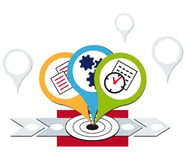The Future of Procurement in Supply Chain Management
Brian Hoey - May 17, 2018

 Imagine for a moment that you’re at an antiques auction. You’ve scoped out a handful of items that might meet your needs, and you have a strong but flexible sense of how much money you would be willing to spend on any given item. But when the first of your lots is on the auction block, instead of sitting in the auction house, you’re situated at a remote location, watching a live video feed of the proceedings. When you want to place a bid, you have to instruct your representative at the auction house to raise her paddle. Naturally, by the time you’ve done this, the price that you’re acting on is already out of date. As a result, you wind up with none of the items you had hoped for, even in cases where you might have been willing to spend more on them than the price that they ultimately went for.
Imagine for a moment that you’re at an antiques auction. You’ve scoped out a handful of items that might meet your needs, and you have a strong but flexible sense of how much money you would be willing to spend on any given item. But when the first of your lots is on the auction block, instead of sitting in the auction house, you’re situated at a remote location, watching a live video feed of the proceedings. When you want to place a bid, you have to instruct your representative at the auction house to raise her paddle. Naturally, by the time you’ve done this, the price that you’re acting on is already out of date. As a result, you wind up with none of the items you had hoped for, even in cases where you might have been willing to spend more on them than the price that they ultimately went for.
This scenario might seem a bit farfetched, but it represents a real snapshot of what the procurement process has been like for many businesses over the years. Out of date quotations and inefficient processes lead to businesses consistently leaving value on the table and settling for prices that don’t reflect current market trends or their own particular needs. In the era of Industry 4.0, however, we’re finally beginning to see some meaningful changes to these process, as factors as diverse as Internet of Things (IoT) devices and real-time fuel pricing contribute a smarter marketplace. For shippers and freight forwarders who are able to take advantage of new technological innovations, procurement can become not just an uphill battle to save money, but an opportunity to add meaningful business value.
Letting Go of the Past
As supply chains become increasingly digitized, the amount of information available to planners is rapidly increasingly, ranging from instructive past data to real-time information on tariffs, fuel prices, potential price breaks, shifting capacity restrictions, and other information pertinent to managing transport logistics. With this information at hand, buyers can begin to gain an understanding of the optimal transport choices for their particular needs.
Without this plethora of data, businesses only have past needs and pricing matrices to rely on. The result is that new strategies and the most recent forecasts often have little sway in the pricing process. This tends to result in pricing misalignments that fail to reflect changing circumstances in both short- and mid-term plans. Of course, no supply chain manager has a crystal ball, and it’s impossible to see the future, but by unshackling yourself from past needs and looking instead toward future possibilities, it’s possible to further optimize the procurement process, reducing the number of out-of-date tenders while making decisions that align with your forecasted needs.
Of course, when it comes to forecasting future needs, a digital supply chain and an Industry 4.0 mindset can be real drivers of increased accuracy and added value. By decreasing information silos and eliminating Shadow IT, Industry 4.0 enables businesses to improve their overall data quality and visibility. The result is not just a more transparent value chain, but easier integration of advanced analytics, machine learning software, and other technologies that can help improve forecast quality (and therefore pricing and buying of transport).
Creating Value
Once you’ve oriented your internal processes around accurately forecasting future needs, it’s time to start delving even deeper into what a digital supply chain can mean for the future of procurement. As you’re increasingly able to take full advantage of real-time supply chain information, it’s possible to work towards a new paradigm that does more than just minimize costs. For instance, with increased data visibility it’s possible for buying processes to take on a more collaborative character. Rather than thinking of freight providers as a necessary expenditure (for many freight forwarders freight costs can be more than 50% of their total operating expenses), it may be possible to work towards more value additive partnerships in which each business shares a common vision and set of facts to create more efficient pricing and buying structures.
In most instances, procurers already operates with an extremely lean mentality, but purchasing can still be a driving force for smarter operational workflows overall. As it becomes more and more sophisticated and increasingly digitized, it will help to create a more agile, adaptable value chain overall, offering businesses the ability to more meaningfully integrate purchasing into other smart processes. By embracing the technological changes that are helping to create more cohesive, holistic operational plans, businesses can turn modern procurement into another spoke in the wheel of Industry 4.0 processes.
LATEST POSTS
- Understand Circular Economy in The Manufacturing Industry
- How Can Industry 4.0 IT Integration Be Achieved Smoothly?
- The Significance of Order Sequencing in Discrete Manufacturing
- How to improve your Supply Chain Management: The Power of Control Towers
- Optimizing Human Resource Scheduling in Manufacturing: A Technological Approach



